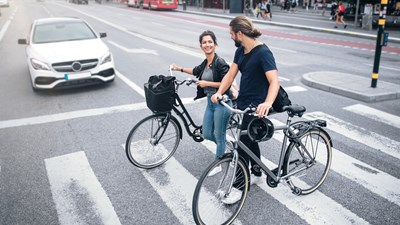Putting your mobility on the road to 2030
There are various possibilities for offering your employees flexible mobility. And you don’t need to make all your changes at once. A gradual implementation of new policy next to the current policy makes it possible to experiment. Individual mobility is tailored to the phase of life, the living situation and career of each individual employee. And it’s implemented without you, as an employer, having to do any extra work! An ‘Employee benefit’ solution with mobility for everyone.
Additional mismatch between mobility needs and solutions
Millennials (everyone born after 1980) represent an ever-greater percentage of your employees. How strange is it then that most of the current mobility regulations for lease cars or travel-cost remunerations were created by and for the generation before them? In the short term, this could result in a mismatch between the mobility needs and the mobility range your organisation offers. Various research studies have shown that millennials find other things (more) important. They want to be involved in cool projects and work in a fun and sustainable environment, with a healthy work-life balance.
Often, millennials prefer not to be bound by anything. And to have direct access to... being flexible. They have Spotify and Netflix on their phones. They may not own a car if they live in the city, but they have access to a share car, bike or public transport. For them, mobility has to be smart and above all, arranged to be flexible. Which means a lease car with a multi-year contract won’t always meet expectations. Is your mobility range millennial-proof or are you about to lose out in the job market’s War for Talent?
One person linked to one vehicle is sooooo 2019...
Fewer and fewer people want to commit themselves to a long-running lease contract for one specific vehicle. In the near future, people will choose the best mode of transport based on their travel needs at that particular moment.
Sometimes the car, sometimes public transport and at other times, a bicycle, scooter or motorbike. Fortunately, more and more frequently, the choice is for the most sustainable mobility solution! Mobility is evolving for employees without lease cars as well. For this group of employees, we have noted a tendency: organisations want to offer them flexible, sustainable and safe mobility solutions.
A mobility budget opens a lot of doors. Working from home has, in the meantime, become very much embedded and promises to be a permanent solution for many employees—at least for a part of the work week. The company car will therefore be driven less, opening the door to the mobility budget. The employee can choose, for example, a smaller, more environmentally friendly car with a lower TCO, combined with a lease bike and other forms of mobility.

Becoming an Employer of Choice
5 Tips for becoming an Employer of Choice by arranging mobility differently
Not everything has to happen at the same time
As an organisation, you can always implement a new mobility budget ‘alongside’ your current, somewhat more traditional policy. By means of pilot groups, you can experiment with what best suits the organisation and employees. As well as this, in due course, it will be possible to use insights and first experiences to convince the rest of the organisation of the value of such approaches. This means of changing also helps internal stakeholders, such as the Works Council to accept the change and, as such, the new situation. A logical pilot group is, for example, new employees, and for a transition period, a selection of current employees.
Tip
Let your employees first try a few of the new solutions. Evaluate these findings together with the Works Council and bring your mobility policy, step by step, into the 21st century.

What about 2030? A look at the future
In the future, it will just take the push of a button to be at any location. Maybe not physically, but as a hologram. Because why exactly would you always have to be physically present? If it is actually necessary every now and again, a drone would be able to transport you to the location where you need to be. Otherwise you might step into a driverless vehicle (would we call it a car?) that is available on a call-up basis. At the end of the journey, using the chip in your arm, you would pay for the kilometres you’d travelled. By then, you might be biking past a traffic jam at speeds of 120 kilometres an hour. With the VeloX bike, the Human Power Team at the TU Delft and the VU Amsterdam is currently investigating all these possibilities.
It will be the fastest bike you’ve ever seen: an aerodynamic recumbent bike that runs on muscle power. If you live in the city and it’s becoming more and more difficult to find a parking space, you might find yourself taking an electric skateboard. An easy last-mile solution for every commuter or traveller. In sketches of future scenarios, we rarely fly. Why not? Because by then, we might shoot through a vacuum tube at a thousand kilometres an hour. The hyperloop solution might turn long-distance transport of people and goods completely upside down. It’s sustainable, safe and the costs are lower than, for example, flying or catching a high-speed train.

